Deriving Mobility Service Policy Issues Based on Text Mining: A Case Study of Gyeonggi Province in South Korea
Abstract
1. Introduction
2. Related Works
2.1. Mobility Service
2.2. Text Mining
2.3. The Status and Major Issues of Mobility in Gyeonggi Province
2.3.1. Description of the Study Site
2.3.2. SWOT Analysis on Mobility in Gyeonggi Province
- Strengths
- Weaknesses
- Opportunities
- Threats
3. Methodology
3.1. Data Collection
3.2. Text Preprocessing
3.3. Frequency Analysis
3.4. TF-IDF
3.4.1. TF
3.4.2. DF
3.4.3. IDF
3.4.4. TF-IDF Term Weights
3.5. Clustering
3.5.1. K-Means
| Algorithm 1: K-means | ||
| Input: | ||
| Output: | ||
3.5.2. Average Silhouette Method
4. Results
4.1. Frequency Analysis Result
4.2. Result of the TF-IDF
4.3. K-Means Application Result
4.4. Verification of the SWOT Analysis Result in Gyeonggi Province
5. Conclusions
5.1. Summary and Implications
5.2. Limitations and Future Research
Author Contributions
Funding
Acknowledgments
Conflicts of Interest
References
- Adey, P. Mobility, 2nd ed.; Routledge: Abingdon-on-Thames, UK, 2017. [Google Scholar]
- Campisi, T.; Akgün, N.; Ticali, D.; Tesoriere, G. Exploring Public Opinion on Personal Mobility Vehicle Use: A Case Study in Palermo, Italy. Sustainability 2020, 12, 5460. [Google Scholar] [CrossRef]
- Zagorskas, J.; Burinskienė, M. Challenges Caused by Increased Use of E-Powered Personal Mobility Vehicles in European Cities. Sustainability 2020, 12, 273. [Google Scholar] [CrossRef]
- Wang, H.; Grindle, G.G.; Candiotti, J.; Chung, C.; Shino, M.; Houston, E.; Cooper, R.A. The Personal Mobility and Manipulation Appliance (PerMMA): A Robotic Wheelchair with Advanced Mobility and Manipulation. In Proceedings of the 2012 Annual International Conference of the IEEE Engineering in Medicine and Biology Society, San Diego, CA, USA, 28 August–1 September 2012; pp. 3324–3327. [Google Scholar]
- Barr, S. Personal mobility and climate change. Wires Clim. Chang. 2018, 9, e542. [Google Scholar] [CrossRef]
- Whim. All Transport in One App. Available online: https://whimapp.com/ (accessed on 9 September 2020).
- Jittrapirom, P.; Caiati, V.; Feneri, A.; Ebrahimigharehbaghi, S.; González, M.; Narayan, J. Mobility as a Service: A Critical Review of Definitions, Assessments of Schemes, and Key Challenges. Urban Plan. 2017, 2, 13–25. [Google Scholar] [CrossRef]
- Motta, G.; Sacco, D.; Ma, D.; You, D.; Liu, K. Personal Mobility Service System in Urban Areas: The IRMA Project. In Proceedings of the 2015 IEEE Symposium on Service-Oriented System Engineering, San Francisco Bay, CA, USA, 30 March–3 April 2015; pp. 88–97. [Google Scholar]
- Bösch, P.M.; Becker, F.; Becker, H.; Axhausen, K.W. Cost-based analysis of autonomous mobility services. Transp. Policy 2018, 64, 76–91. [Google Scholar] [CrossRef]
- Dandl, F.; Hyland, M.; Bogenberger, K.; Mahmassani, H.S. Evaluating the impact of spatio-temporal demand forecast aggregation on the operational performance of shared autonomous mobility fleets. Transportation 2019, 46, 1975–1996. [Google Scholar] [CrossRef]
- Szigeti, S.; Csiszár, C.; Földes, D. Information Management of Demand-responsive Mobility Service Based on Autonomous Vehicles. Procedia Eng. 2017, 187, 483–491. [Google Scholar] [CrossRef]
- Gwon, Y.M.; Kim, H.J.; Lim, G.I.; Kim, J.H.; Son, W.B. A Research on Forecasting Change and Service Direction for the Future Mobility System. Korea Inst. Intell. Transp. Syst. 2020, 19, 100–115. [Google Scholar]
- Kwon, Y.M.; Kim, S.J.; Kim, H.J.; Byun, J.H. What Attributes Do Passengers Value in Electrified Buses? Energies 2020, 13, 2646. [Google Scholar] [CrossRef]
- Jeong, S.; Yoon, H. QAP Structural Characterization of Public Transportation Networks based on QAP Correlation. J. Inf. Technol. Appl. Manag. 2019, 26, 95–102. [Google Scholar]
- Korea Transportation Safety Authority. 2018 Public Transportation Investigation. 2018. Available online: http://stat.molit.go.kr/portal/cate/statMetaView.do?hRsId=483&hFormId=5499&hSelectId=5499&sStyleNum=1&sStart=2011&sEnd=2011&hPoint=00&hAppr=1&oFileName=&rFileName=&midpath= (accessed on 3 September 2020).
- Korea Appraisal Board. Korea Housing Price Index. 2018. Available online: https://www.housing.or.kr/user/boardList.do?command=view&page=2&boardId=21825&boardSeq=24411&id=home_030300000000 (accessed on 3 September 2020).
- Beutel, M.C.; Gökay, S.; Kluth, W.; Krempels, K.; Samsel, C.; Terwelp, C. Product Oriented Integration of Heterogeneous Mobility Services. In Proceedings of the 17th International IEEE Conference on Intelligent Transportation Systems (ITSC), Qingdao, China, 8–11 October 2014; pp. 1529–1534. [Google Scholar]
- Ibrahim, A.; Zhao, L. Supporting the OSGi Service Platform with Mobility and Service Distribution in Ubiquitous Home Environments. Comput. J. 2009, 52, 210–239. [Google Scholar] [CrossRef]
- Frändberg, L.; Vilhelmson, B. More or less travel: Personal mobility trends in the Swedish population focusing gender and cohort. J. Transp. Geogr. 2011, 19, 1235–1244. [Google Scholar] [CrossRef]
- Alanne, K.; Cao, S. Zero-energy hydrogen economy (ZEH2E) for buildings and communities including personal mobility. Renew. Sustain. Energy Rev. 2017, 71, 697–711. [Google Scholar] [CrossRef]
- Podobnik, J.; Rejc, J.; Slajpah, S.; Munih, M.; Mihelj, M. All-Terrain Wheelchair: Increasing Personal Mobility with a Powered Wheel-Track Hybrid Wheelchair. IEEE Robot. Autom. Mag. 2017, 24, 26–36. [Google Scholar] [CrossRef]
- Schwanen, T. Innovations to transform personal mobility. In Low Carbon Mobility Transitions; Hopkins, D., Higham, J., Eds.; Goodfellow Publishers: London, UK, 2016; pp. 154–196. [Google Scholar]
- Distler, V.; Lallemand, C.; Bellet, T. Acceptability and Acceptance of Autonomous Mobility on Demand: The Impact of an Immersive Experience. In Proceedings of the 2018 CHI Conference on Human Factors in Computing Systems, Montreal, QC, Canada, 21–26 April 2018; pp. 1–10. [Google Scholar]
- Kwon, Y.M.; Son, S.H.; Jang, K.T. User satisfaction with battery electric vehicles in South Korea. Transp. Res. Part D Transp. Environ. 2020, 82, 102306. [Google Scholar] [CrossRef]
- Hong, S.Y. A Study on the Introduction of Smart Mobility Service in Seoul; The Seoul Institute: Seoul, Korea, 2019; Available online: https://www.si.re.kr/node/62534 (accessed on 4 September 2020).
- Gyeonggi Province Government. A Strategy for Smart Mobility in Gyeonggi Province-Type; Gyeonggi Province Government: Seongnam City, Korea, 2019.
- Cirianni, F.; Monterosso, C.; Panuccio, P.; Rindone, C. A review methodology of sustainable urban mobility plans: Objectives and actions to promote cycling and pedestrian mobility. In Smart and Sustainable Planning for Cities and Regions; Bisello, A., Vettorato, D., Laconte, P., Costa, S., Eds.; Springer: Cham, Switzerland, 2018; pp. 685–697. [Google Scholar]
- Russo, F.; Rindone, C. The Planning Process and Logical Framework Approach in Road Evacuation: A Coherent Vision. In Proceedings of the 4th International Conference on Safety and Security Engineering, Antwerp, Belgium, 4–6 July 2011; pp. 415–425. [Google Scholar]
- Amrita, C.; Paauwb, T.; Alyc, R.; Lavrica, M. Identifying child abuse through text mining and machine learning. Expert Syst. Appl. 2017, 88, 402–418. [Google Scholar] [CrossRef]
- Tang, V.; Siu, P.K.Y.; Choy, K.L.; Ho, G.T.S.; Lam, H.Y.; Tsang, Y.P. A web mining-based case adaptation model for quality assurance of pharmaceutical warehouses. Int. J. Logist. Res. Appl. 2019, 22, 325–348. [Google Scholar] [CrossRef]
- Tang, V.; Siu, P.K.Y.; Choy, K.L.; Lam, H.Y.; Ho, G.T.S.; Lee, C.K.M.; Tsang, Y.P. An adaptive clinical decision support system for serving the elderly with chronic diseases in healthcare industry. Expert Syst. 2019, 36, e12369. [Google Scholar] [CrossRef]
- Orellana, G.; Orellana, M.; Saquicela, V.; Baculima, F.; Piedra, N. A Text Mining Methodology to Discover Syllabi Similarities among Higher Education Institutions. In Proceedings of the 2018 International Conference on Information Systems and Computer Science (INCISCOS), Quito, Ecuador, 14–16 November 2018; pp. 261–268. [Google Scholar]
- Jeong, H.R.; Park, S.M.; Jun, Y.J.; Choi, J.W.; Choe, B.H.; Park, K.H.; Yun, I.S. Reclassification of Traffic Crashes Using Traffic Crash Report Data and Keyword Analysis. In Proceedings of the 13th International Conference on Probabilistic Safety Assessment and Management (PSAM 13), Seoul, Korea, 2–7 October 2016. [Google Scholar]
- So, J.H.; Kim, T.H.; Kim, M.J.; Kang, J.W.; Lee, H.; Choi, J.M. A Study on the Concept of Smart City and Smart City Transport. J. Korean Soc. Transp. 2019, 37, 79–91. [Google Scholar] [CrossRef]
- Song, M.; Kim, M.C.; Jeong, Y.K. Analyzing the Political Landscape of 2012 Korean Presidential Election in Twitter. IEEE Intell. Syst. 2014, 29, 18–26. [Google Scholar] [CrossRef]
- Charalampakis, B.; Spathis, D.; Kouslis, E.; Kermanidis, K. A comparison between semi-supervised and supervised text mining techniques on detecting irony in greek political tweets. Eng. Appl. Artif. Intell. 2016, 51, 50–57. [Google Scholar] [CrossRef]
- Chae, Y.S.; Lee, S.H. Identification of Strategic Fields for Developing Smart City in Busan Using Text Mining. J. Digit. Converg. 2018, 16, 1–15. [Google Scholar]
- Chen, K.; Zhang, Z.; Long, J.; Zhang, H. Turning from TF-IDF to TF-IGM for term weighting in text classification. Expert. Syst. Appl. 2016, 66, 245–260. [Google Scholar]
- Yahav, I.; Shehory, O.; Schwartz, D. Comments mining with TF-IDF: The inherent bias and its removal. IEEE Trans. Knowl. Data Eng. 2018, 31, 437–450. [Google Scholar] [CrossRef]
- Gyeonggi Autonomous Driving Center. A Study on the Development of Mobility Service Ecosystem; Gyeonggi Autonomous Driving Center: Gyeonggi, Korea, 2020. [Google Scholar]
- Lilleberg, J.; Zhu, Y.; Zhang, Y. Support Vector Machines and Word2vec for Text Classification with Semantic Features. In Proceedings of the 2015 IEEE 14th International Conference on Cognitive Informatics & Cognitive Computing, Beijing, China, 6–8 July 2015; pp. 136–140. [Google Scholar]
- Han, S.S.; Yang, D.W. Analysis of Research Trends Related to Start-Up Using Text Mining. Korean Soc. Bus. Ventur. 2017, 12, 1–12. [Google Scholar]
- Robertson, S. Understanding inverse document frequency: On theoretical arguments for IDF. J. Doc. 2004, 60, 503–520. [Google Scholar] [CrossRef]
- Havrlant, L.; Kreinovich, V. A simple probabilistic explanation of term frequency-inverse document frequency (tf-idf) heuristic (and variations motivated by this explanation). Int. J. Gen. Syst. 2017, 46, 27–36. [Google Scholar] [CrossRef]
- Jing, L.P.; Huang, H.K.; Shi, H.B. Improved feature selection approach TFIDF in text mining. In Proceedings of the International Conference on Machine Learning and Cybernetics, Beijing, China, 4–5 November 2002; pp. 944–946. [Google Scholar]
- Kim, D.; Seo, D.; Cho, S.; Kang, P. Multi-co-training for document classification using various document representations: TF–IDF, LDA, and Doc2Vec. Inf. Sci. 2019, 477, 15–29. [Google Scholar] [CrossRef]
- Metropolitan Transport Commission. Metropolitan Transportation 2030. 2020. Available online: https://www.molit.go.kr/metro/main.jsp (accessed on 4 September 2020).
- Armacost, R.L.; Componation, P.K.; Mullens, M.A.; Swart, W.W. An AHP framework for prioritizing customer requirements in QFD: An Industrialized Housing Application. IIE Trans. 1994, 26, 72–79. [Google Scholar] [CrossRef]
- Al-Harbi, K.M.A.S. Application of the AHP in project management. Int. J. Proj. Manag. 2001, 19, 19–27. [Google Scholar] [CrossRef]
- Turoń, P.; Kubic, A.; Chen, F.; Wang, H.; Łazarz, B. A Holistic Approach to Electric Shared Mobility Systems Development—Modelling and Optimization Aspects. Energies 2020, 13, 5810. [Google Scholar] [CrossRef]
- Turoń, P.; Kubik, A. Economic Aspects of Driving Various Types of Vehicles in Intelligent Urban Transport Systems, Including Car-Sharing Services and Autonomous Vehicles. Appl. Sci. 2020, 10, 5580. [Google Scholar] [CrossRef]
- Dalkey, N.; Brown, B.; Cochran, S. Use of Self-ratings to Improve Group Estimates: Experimental Evaluation of Delphi Procedures. Technol. Forecast. 1970, 1, 283–291. [Google Scholar] [CrossRef]
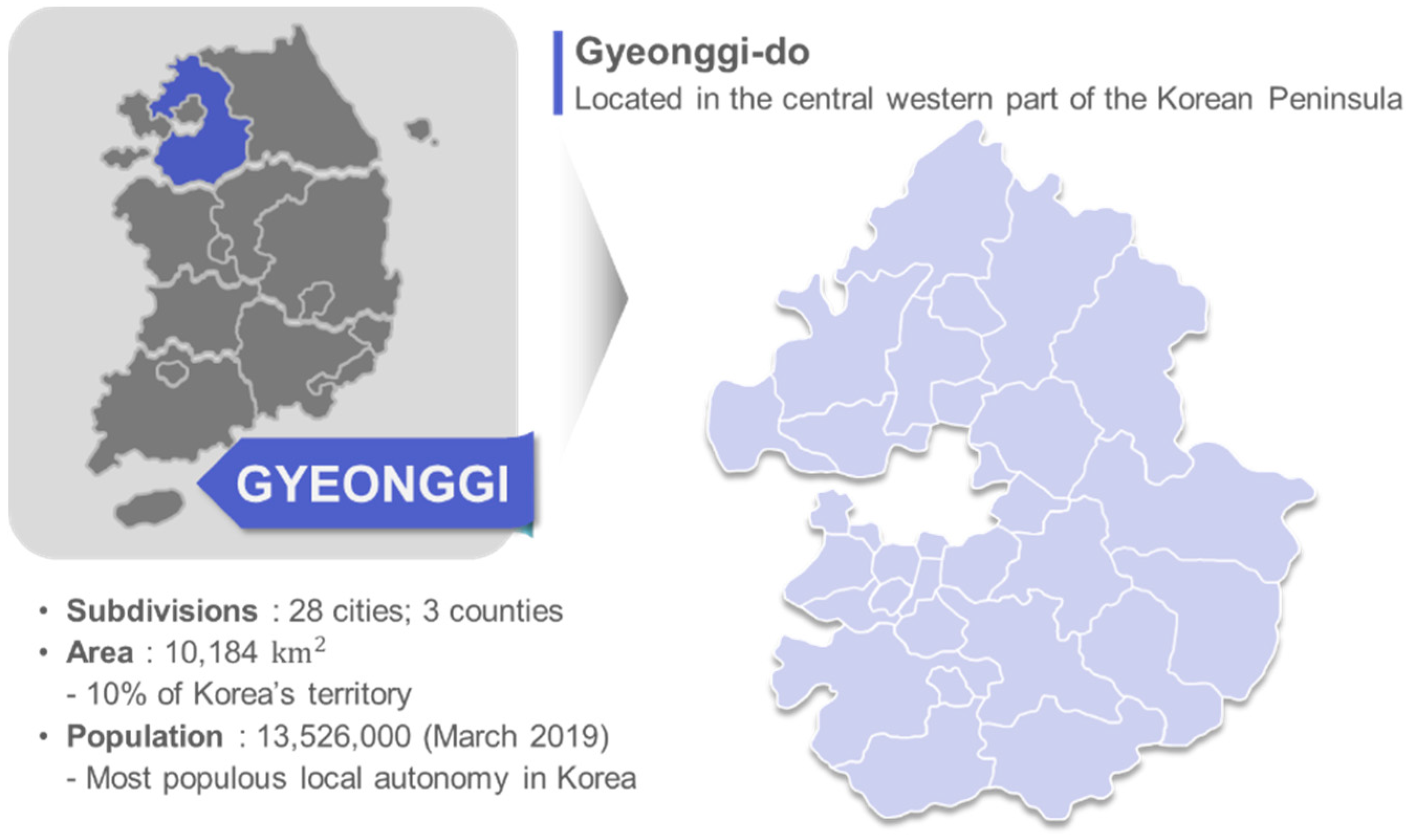
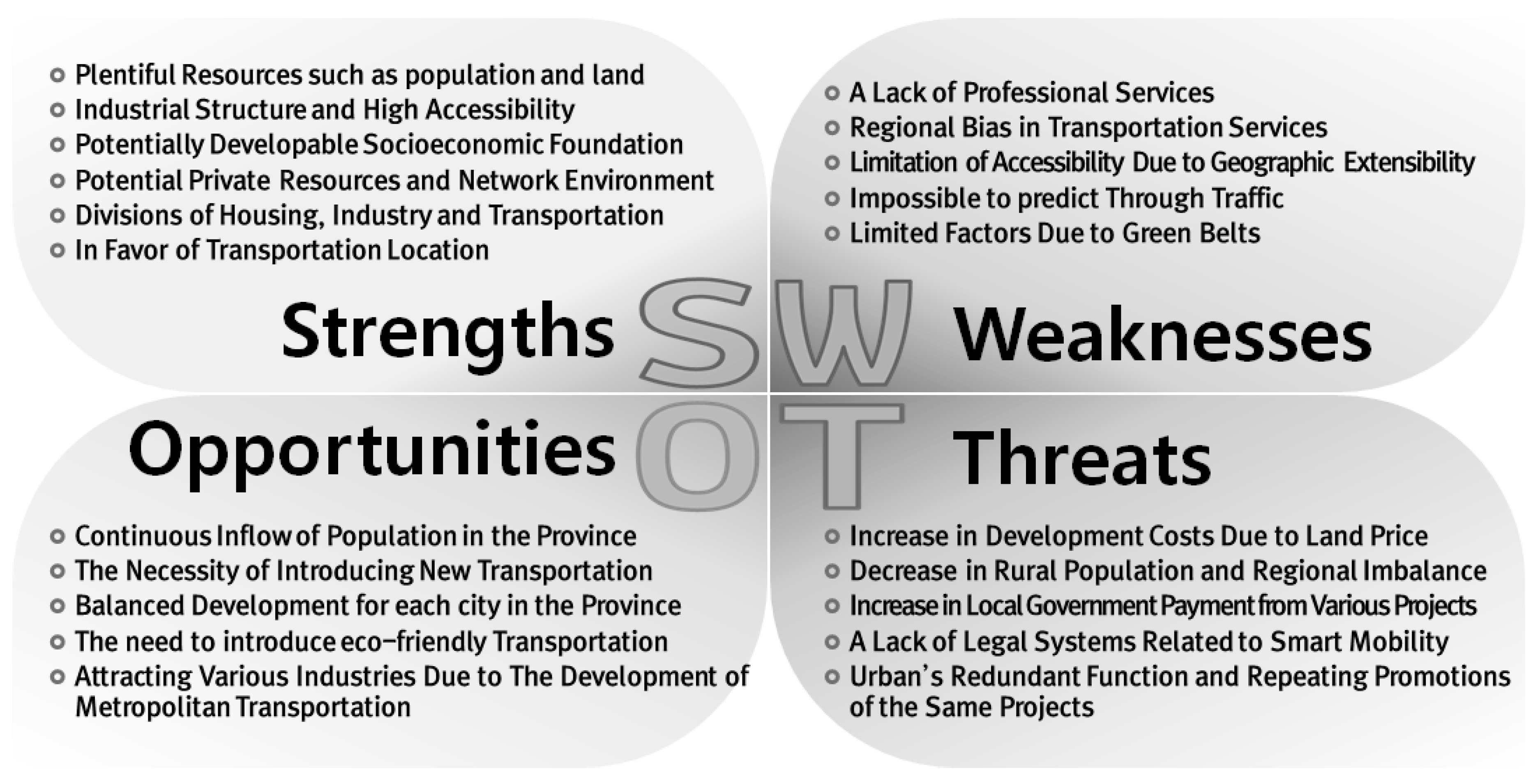
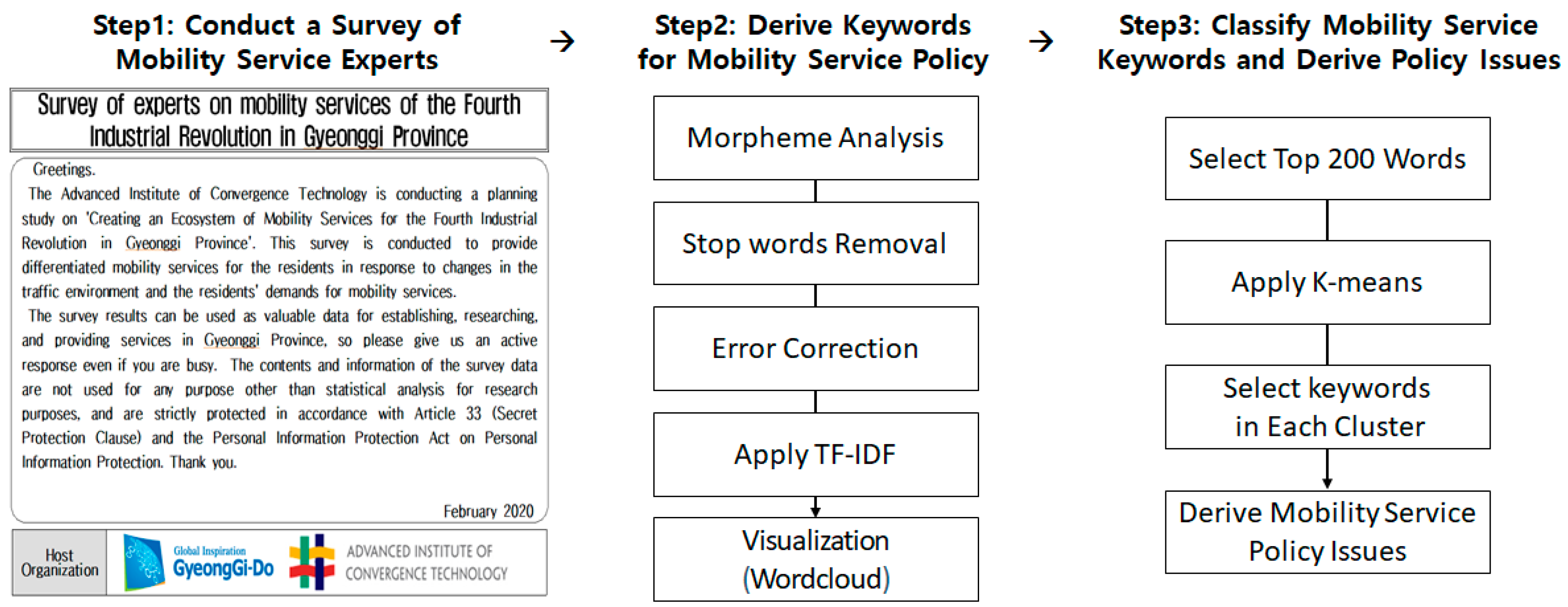
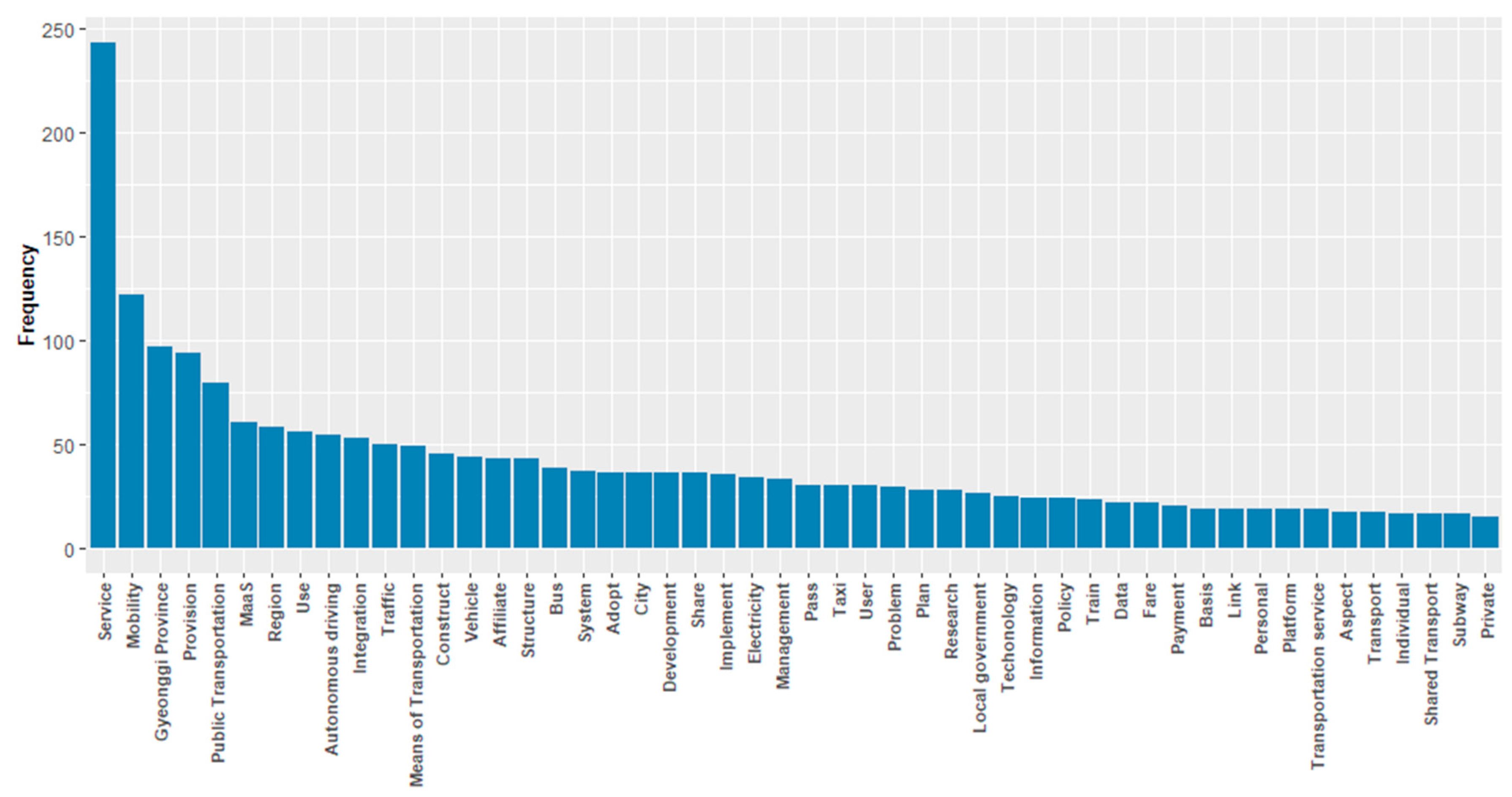

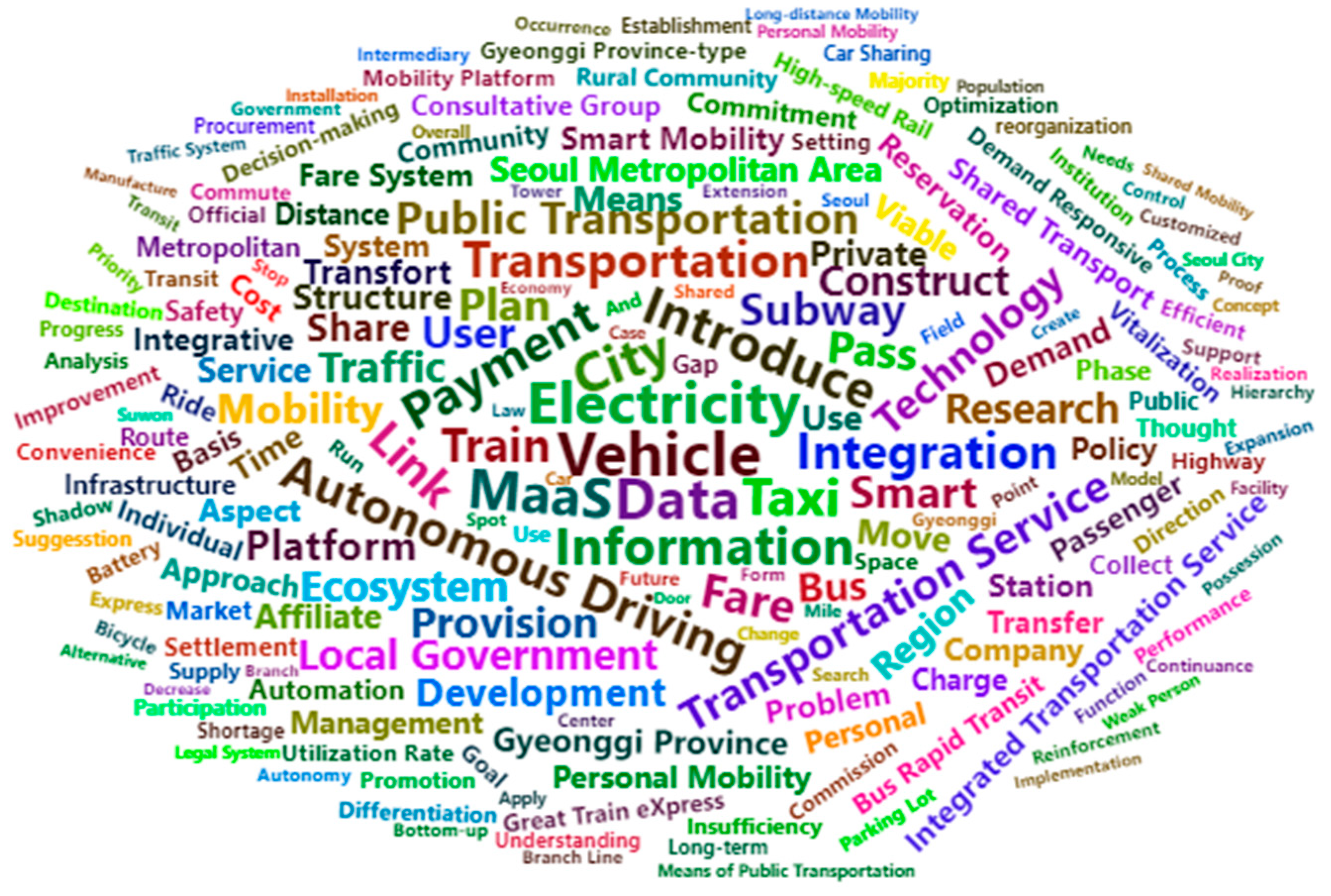
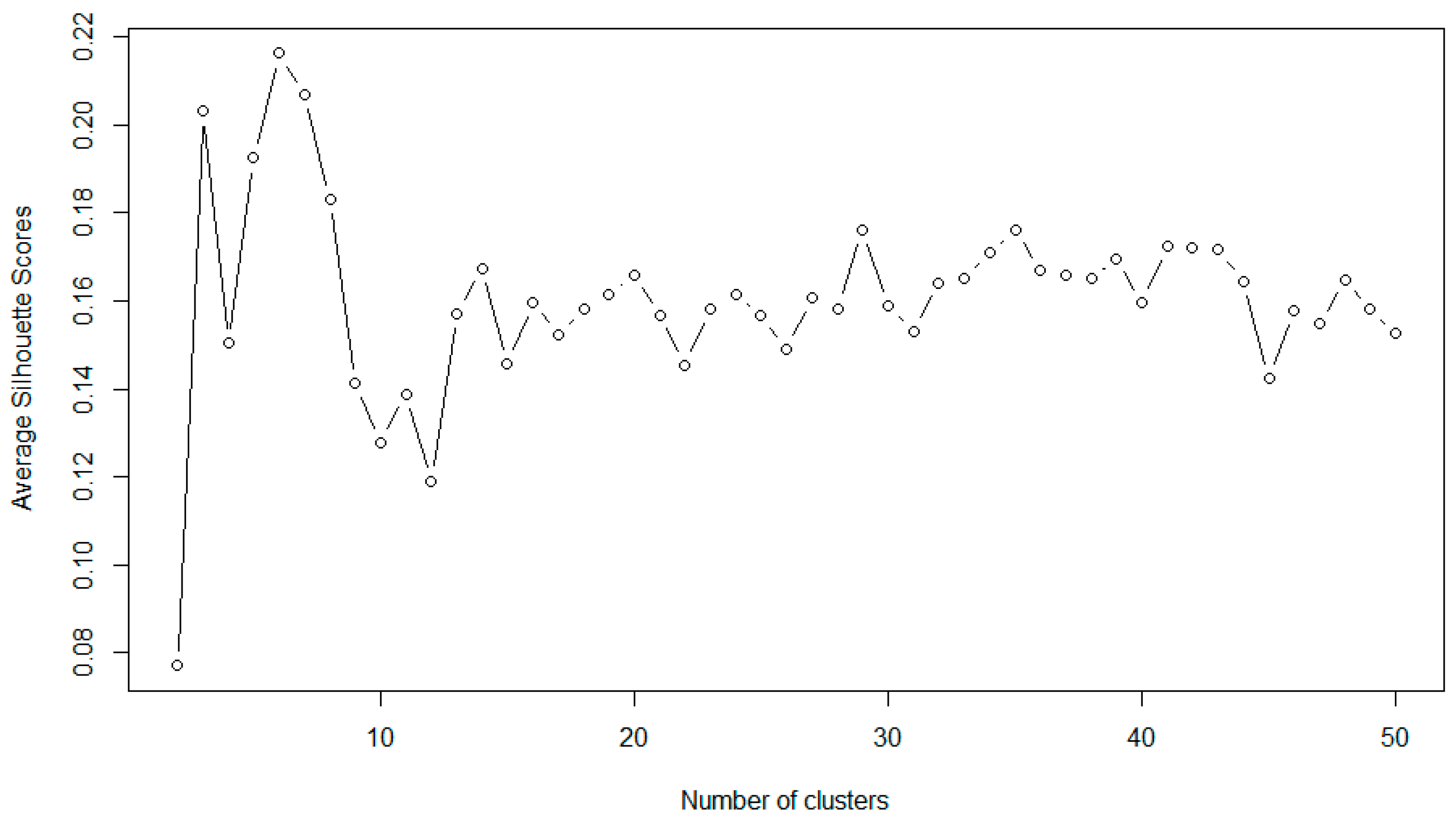
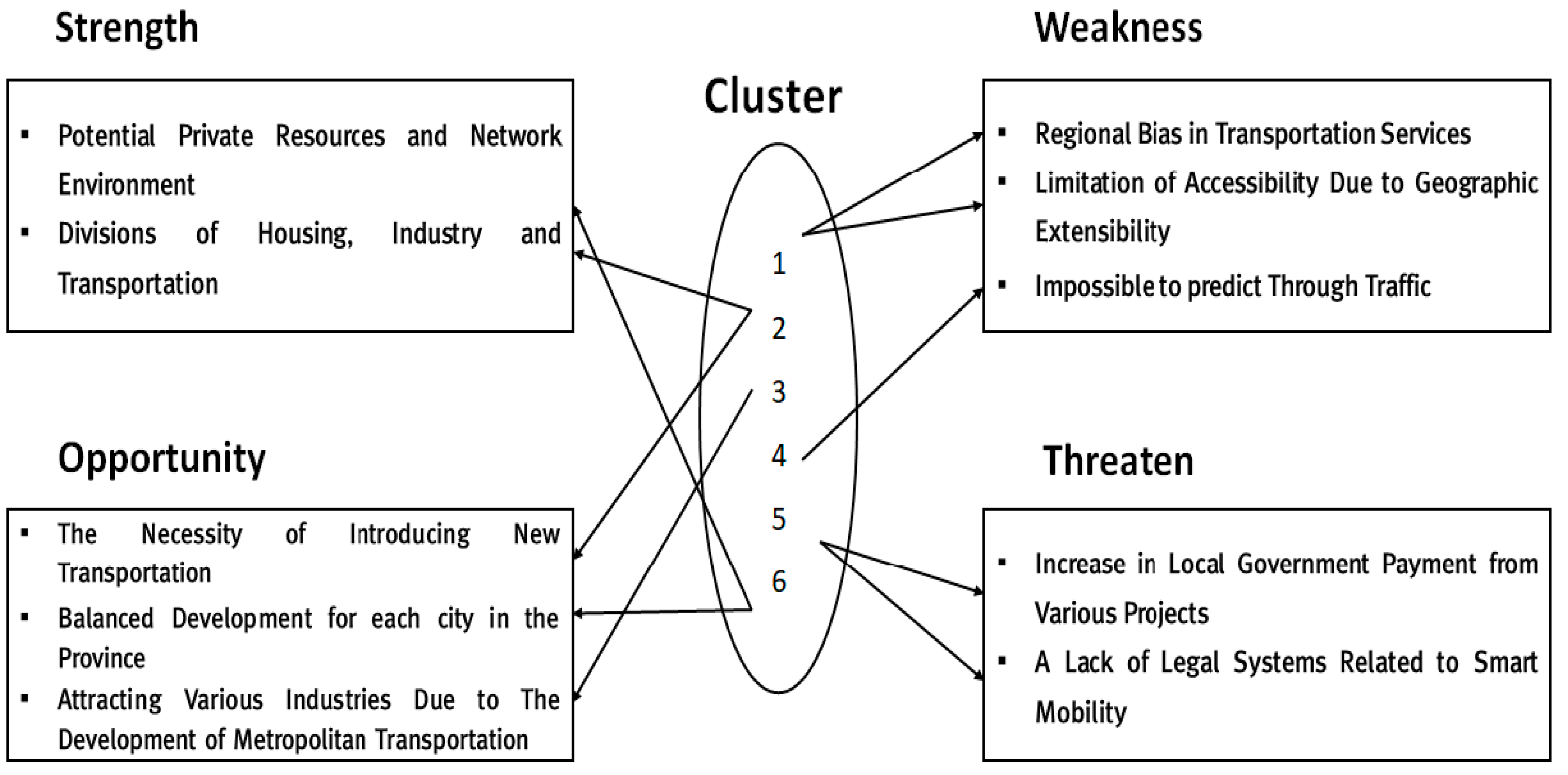
| Sample Attributes | Category | Number (%) |
|---|---|---|
| Sample size | 36 | |
| Gender | Male Female | 32 (88.9) 4 (11.1) |
| Age | <36 36–45 45> | 9 (25.0) 22 (61.1) 5 (13.9) |
| Degree | Master Doctor | 2 (5.6) 34 (94.4) |
| Major | Transportation Urban | 28 (77.8) 8 (22.2) |
| Occupation | Professor Researcher | 20 (55.6) 16 (44.4) |
| Name | Frequency | % in Total | Document Frequency |
|---|---|---|---|
| Service | 243 | 4.72% | 32 |
| Mobility | 122 | 2.37% | 28 |
| Gyeonggi Province | 97 | 1.88% | 28 |
| Provision | 94 | 1.82% | 26 |
| Public Transportation | 79 | 1.53% | 24 |
| MaaS | 60 | 1.16% | 19 |
| Region | 58 | 1.13% | 23 |
| Use | 56 | 1.09% | 23 |
| Autonomous Driving | 54 | 1.05% | 19 |
| Integration | 53 | 1.03% | 19 |
| Traffic | 50 | 0.97% | 20 |
| Means of Transportation | 49 | 0.95% | 18 |
| Construct | 45 | 0.87% | 19 |
| Vehicle | 44 | 0.85% | 14 |
| Affiliate | 43 | 0.83% | 21 |
| Structure | 43 | 0.83% | 20 |
| Bus | 38 | 0.74% | 17 |
| System | 37 | 0.72% | 20 |
| Development | 36 | 0.70% | 17 |
| Share | 36 | 0.70% | 17 |
| City | 36 | 0.70% | 13 |
| Adopt | 36 | 0.70% | 13 |
| Implement | 35 | 0.68% | 18 |
| Electricity | 34 | 0.66% | 11 |
| Management | 33 | 0.64% | 19 |
| User | 30 | 0.58% | 13 |
| Taxi | 30 | 0.58% | 11 |
| Pass | 30 | 0.58% | 13 |
| Problem | 29 | 0.56% | 17 |
| Plan | 28 | 0.54% | 12 |
| Research | 28 | 0.54% | 13 |
| Local Government | 26 | 0.50% | 12 |
| Technology | 25 | 0.49% | 11 |
| Information | 24 | 0.47% | 8 |
| Policy | 24 | 0.47% | 15 |
| Name | TF-IDF (w) | Avg. | Std. | Rank in Freq. |
|---|---|---|---|---|
| Vehicle | 38.52 | 1.07 | 2.06 | 14 |
| Electricity | 37.35 | 1.04 | 1.95 | 24 |
| Data | 36.03 | 1.00 | 3.07 | 37 |
| MaaS | 35.27 | 0.98 | 1.78 | 6 |
| City | 34.00 | 0.94 | 1.79 | 21 |
| Introduce | 34.00 | 0.94 | 1.68 | 22 |
| Information | 33.27 | 0.92 | 2.19 | 34 |
| Taxi | 32.96 | 0.92 | 2.48 | 27 |
| Payment | 32.75 | 0.91 | 2.16 | 39 |
| Autonomous Driving | 31.74 | 0.88 | 1.10 | 9 |
| Transportation | 31.31 | 0.87 | 1.31 | 12 |
| Integration | 31.15 | 0.87 | 1.18 | 10 |
| Link | 31.11 | 0.86 | 2.20 | 43 |
| Fare | 30.50 | 0.85 | 1.83 | 38 |
| Train | 29.46 | 0.82 | 2.07 | 36 |
| Public Transportation | 28.81 | 0.80 | 0.88 | 5 |
| Subway | 28.67 | 0.80 | 2.58 | 49 |
| Transportation Service | 28.58 | 0.79 | 1.79 | 41 |
| Smart | 28.56 | 0.79 | 3.40 | 61 |
| Plan | 28.52 | 0.79 | 1.54 | 30 |
| User | 28.33 | 0.79 | 1.47 | 26 |
| Pass | 28.33 | 0.79 | 1.36 | 28 |
| Technology | 27.47 | 0.76 | 1.44 | 33 |
| Provision | 27.04 | 0.75 | 0.79 | 4 |
| Traffic | 26.95 | 0.75 | 0.89 | 11 |
| Ecosystem | 26.88 | 0.75 | 3.00 | 51 |
| Local Government | 26.48 | 0.74 | 1.90 | 32 |
| Construct | 26.45 | 0.73 | 1.03 | 13 |
| Research | 26.44 | 0.73 | 1.56 | 31 |
| Mobility | 26.38 | 0.73 | 0.76 | 2 |
| Platform | 26.34 | 0.73 | 2.05 | 44 |
| Bus | 26.34 | 0.73 | 1.02 | 17 |
| Development | 24.95 | 0.69 | 1.01 | 19 |
| Share | 24.95 | 0.69 | 1.03 | 20 |
| Region | 23.52 | 0.65 | 0.77 | 7 |
| Cluster 1 | Cluster 2 | Cluster 3 | Cluster 4 | Cluster 5 | Cluster 6 |
|---|---|---|---|---|---|
| Vehicle | City | Transportation | Data | Introduce | Ecosystem |
| Taxi | Autonomous Driving | Seoul Metropolitan Area | Information | Local Government | Viable |
| Payment | Public Transportation | Smart Mobility | User | Research | Market |
| Link | Subway | Shared Transport | Platform | Consultative Group | Utilization Rate |
| Train | Pass | Great Train eXpress | Integrative | Control | |
| Fare System | Vitalization | ||||
| Integrated Transportation Service |
| Gyeonggi-Province-Type Mobility Policy Issues | |
|---|---|
| 1. | Integrated Transportation Service with Taxi and Public Transportation |
| 2. | Urban-based Autonomous Driving Public Transportation |
| 3. | GTX-based Smart Shared Mobility in Seoul Metropolitan Area |
| 4. | Data Platform for Providing Transportation Service |
| 5. | Mobility Service Research through Institutional Collaboration |
| 6. | Viable Mobility Market |
Publisher’s Note: MDPI stays neutral with regard to jurisdictional claims in published maps and institutional affiliations. |
© 2020 by the authors. Licensee MDPI, Basel, Switzerland. This article is an open access article distributed under the terms and conditions of the Creative Commons Attribution (CC BY) license (http://creativecommons.org/licenses/by/4.0/).
Share and Cite
Seo, Y.; Lim, D.; Son, W.; Kwon, Y.; Kim, J.; Kim, H. Deriving Mobility Service Policy Issues Based on Text Mining: A Case Study of Gyeonggi Province in South Korea. Sustainability 2020, 12, 10482. https://doi.org/10.3390/su122410482
Seo Y, Lim D, Son W, Kwon Y, Kim J, Kim H. Deriving Mobility Service Policy Issues Based on Text Mining: A Case Study of Gyeonggi Province in South Korea. Sustainability. 2020; 12(24):10482. https://doi.org/10.3390/su122410482
Chicago/Turabian StyleSeo, Younghoon, Donghyun Lim, Woongbee Son, Yeongmin Kwon, Junghwa Kim, and Hyungjoo Kim. 2020. "Deriving Mobility Service Policy Issues Based on Text Mining: A Case Study of Gyeonggi Province in South Korea" Sustainability 12, no. 24: 10482. https://doi.org/10.3390/su122410482
APA StyleSeo, Y., Lim, D., Son, W., Kwon, Y., Kim, J., & Kim, H. (2020). Deriving Mobility Service Policy Issues Based on Text Mining: A Case Study of Gyeonggi Province in South Korea. Sustainability, 12(24), 10482. https://doi.org/10.3390/su122410482





